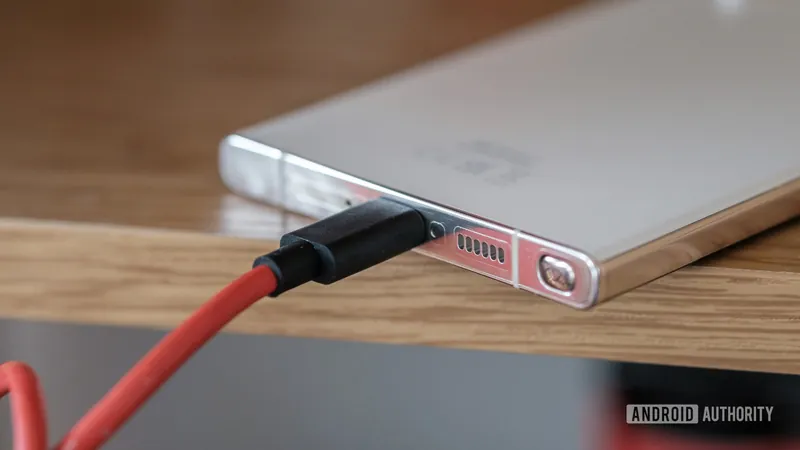
Is the USB-C Dream Dead? Unraveling the Chaos of Compatibility
2025-06-08
Author: Yan
The Rise and Fall of USB-C
For nearly a decade, the promise of USB-C was clear: a universal connector that could charge devices, transfer data, and support peripherals, all through a single port. However, the reality has been a tangled mess of compatibility issues and endless confusion, leaving many to wonder if the USB-C dream is, in fact, dead.
The Compatibility Nightmare
Take a look at your living room. How many power adapters and chargers can you name? Which one charges your gadgets the fastest? The introduction of USB-C was supposed to simplify things, but the explosion of different charging standards and data transfer protocols has turned simple tasks into a guessing game.
With USB-C, determining which port does what can feel like a game of 'Guess Who'. The more devices you own, the more complicated it gets. Brands have muddied the waters further with their proprietary technologies that don’t play well with one another.
Some Progress, But Major Setbacks
While recent regulatory changes, like the EU mandate for USB Power Delivery (USB PD) for devices above 15W, have pushed for quicker and more reliable charging options, actual consumer experiences remain inconsistent. Despite efforts to standardize, the array of cables, chargers, and standards makes it hard for the average consumer to keep up.
Meanwhile, China's own initiatives, such as the Universal Fast Charging Specification (UFCS), aim for unification, but without backward compatibility, many legacy chargers will continue to clutter drawers.
Data Transfer Confusion Redefined
USB-C is not just about charging; data transfer is another realm of confusion. The absence of a mandatory protocol means speeds can vary wildly, leaving consumers scratching their heads over which USB-C port is the fastest.
Even the introduction of USB4, designed to clarify specifications, only added to the chaos, creating a tangled web of generations and variations, each with its own capabilities. What's more, the market is riddled with counterfeit and low-quality cables, complicating the search for reliable solutions.
Apple's Half-Hearted Move to USB-C
Apple's recent shift to USB-C with the iPhone 15 series was highly anticipated, yet it has proven to be a misstep rife with inconsistencies. While the Pro models boast faster data speeds, the basic versions lag behind, still using slow USB 2.0 ports. This half-hearted adoption highlights Apple's lack of commitment to simplifying the user experience, instead opting for other features like MagSafe.
The USB-C Landscape: A Mess of Standards
Despite being in existence for over a decade, USB-C has not delivered the seamless, plug-and-play experience that was promised. Even with the widespread use of USB-C across devices, users often find themselves overwhelmed by varying standards and the necessity of multiple chargers and cables.
The initial goal of reducing e-waste and streamlining device connectivity has instead resulted in cluttered drawers filled with obsolete technology and accessories. If USB-C ever does achieve the unification it promises, what happens to all the obsolete tech we’ve accumulated?
A Missed Opportunity for Simplicity
USB-C had the potential to revolutionize the way we connect devices, yet it stumbles on the most fundamental promise: simplicity. Rather than fostering a clear and cohesive ecosystem, it has devolved into a dizzying array of options, missing a prime opportunity to streamline technology for consumers.
As we move deeper into the USB-C era, one thing is clear: the dream of a tidy, unified charging and data standard may be slipping further away. What began as an optimistic venture has unfortunately turned into a case study of how not to implement a universal standard in technology.



 Brasil (PT)
Brasil (PT)
 Canada (EN)
Canada (EN)
 Chile (ES)
Chile (ES)
 Česko (CS)
Česko (CS)
 대한민국 (KO)
대한민국 (KO)
 España (ES)
España (ES)
 France (FR)
France (FR)
 Hong Kong (EN)
Hong Kong (EN)
 Italia (IT)
Italia (IT)
 日本 (JA)
日本 (JA)
 Magyarország (HU)
Magyarország (HU)
 Norge (NO)
Norge (NO)
 Polska (PL)
Polska (PL)
 Schweiz (DE)
Schweiz (DE)
 Singapore (EN)
Singapore (EN)
 Sverige (SV)
Sverige (SV)
 Suomi (FI)
Suomi (FI)
 Türkiye (TR)
Türkiye (TR)
 الإمارات العربية المتحدة (AR)
الإمارات العربية المتحدة (AR)